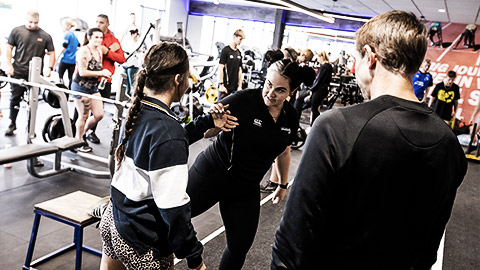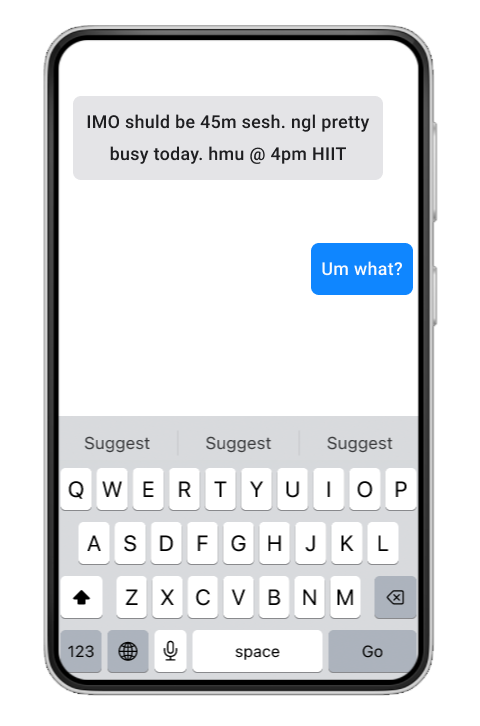Most people listen with the intent to respond, not to understand. Can you recall the last time you felt truly listened to? How did it make you feel?
Clear communication is essential for making a good first impression and providing quality service for clients, colleagues, supervisors, and management.
Benefits of being a skilled communicator:
- Strong client rapport
- Repeat clients and referrals
- Better working relationship with colleagues and improved career prospects
- Enhanced public image
When you’re a PT, you’ll be communicating with clients and colleagues in various mediums.
- Face-to-face: Used for client consultations, staff meetings, interviews, and general conversations with colleagues. Consists of a mix of verbal (via speech) and non-verbal (via body language) communication methods.
- Telephone: Used for client enquiries, making/confirming appointments, and seeking information.
- Email: Used for confirmation of appointments/session times, providing information, communicating instructions or news.
- Social media: Used for business advertising, blogs, vlogs, and image sharing.
- Written: Used for reports, client records, and referrals.
Types of communication
Communication can be verbal or non-verbal. Verbal communication is about language. It includes spoken and written communication. Non-verbal communication is what you convey without words. It includes your posture, facial expressions, gestures, tone of voice, and eye contact.

In the image, what the trainer is saying is verbal communication. Her eye contact with the client, her facial expression, movement, tone of voice, and relaxed body language is non-verbal communication.
Effective verbal communication means using:
- correct terminology (vocabulary).
- language appropriate to the listener.
- correct grammar.
- clear sequence of thoughts and ideas.
- active listening.
Consider your audience
As you progress through your studies, you will build up a wide vocabulary specific to health and fitness. It's important to know the technical terms so you can communicate accurately with colleagues and other professionals. However, it is equally important that you can describe things simply for clients that may not have the same knowledge as you. Always consider who you are communicating with.
Keep it professional
Slang words, nicknames, and acronyms can be confusing to people outside the workplace or industry, and can make you appear unprofessional. Be aware that your clients come from a diverse background. What makes sense to you, might not to others.

If grammar and writing aren’t your strong suit, make sure to use tools such as spellcheck and Grammarly before hitting send. It can help to read your message aloud to see if it makes sense.
Clear sequence
Clients and colleagues will have difficulty understanding your message if your thoughts are confused and your words are jumbled.
This is an example of a poorly sequenced message.
- “Maybe if you…ah…come back when the personal trainer is in…or…no, usually Thursday is a bad day…and Saturday is always busy…Friday morning is okay…and ring first to find out if he’s here.”
This example can be improved by arranging the message in a logical, clear sequence.
- “Please ring to arrange an appointment with the personal trainer. Friday mornings are usually the best time. Thursdays and Saturdays can be quite busy."
Active listening
Listening is an active, non-competitive, two-way interaction.Amy Gallo (Gallo, 2022)
Show respect for your clients and colleagues by listening attentively. Give them time to fully respond to questions. Let them talk.
Watch the video to learn the art of active listening.
Need to watch again? Timestamps:
- 00:00 You might think you’re a good listener, but …
- 00:52 … here’s how to be a “trampoline” listener.
- 01:25 Question 1: How do I usually listen?
- 01:50 Question 2: Why do I need to listen right now?
- 02:35 Question 3: Who is the focus of attention in the conversation?
- 02:54 Question 4: What am I missing?
- 04:30 Question 5: Am I getting in my own way?
- 05:08 Question 6: Am I in an information bubble?
- 06:04 OK, let’s review.
Remember to put away distractions – that means closing your laptop and putting away your phone. Ask yourself what is the goal of the conversation? Listen without an agenda. Process what the other person is saying without formulating a response.
Listen purely for comprehension, without judgement, agenda, or distraction. Speaking up and asking good questions is better than nodding and repeating back.
Take a moment to think about what your default listening style is. Is it:
- task-oriented?
- analytical?
- relational?
- critical?
This next clip is from the animated movie Inside Out. Watch and compare how the different characters listen and respond to each other.
Telephone communication
Now that we've gone through effective verbal communication, let’s consider how this applies to specific mediums.
Great telephone skills are essential to providing good customer service. They can also be one of the hardest skills to master as it is more difficult to communicate when you can't see the client face-to-face. People may get phone shy and stutter, mumble, or talk very quickly when dealing with clients over the phone. Some clients may not answer or only answer in short, incomplete statements until they know who they are speaking with and feel comfortable.
Here are some pointers to help you succeed with phone calls:
- Be prepared – Have a pen and paper for taking notes on hand, or bring the client’s file up on the screen.
- Speak clearly – Use a pleasant tone and be aware of how fast you are talking.
- Smile – It comes across in your tone of voice.
- Answer the call promptly – Within 3 rings is the general rule.
- Use a greeting phrase that identifies you and your business e.g., "Kia ora, Horizon Fitness, this is Ash. How can I help you?”
- Putting people on hold – If you are extremely busy, with multiple calls, then you can put some callers on hold. However, always ask their permission first.
- Build rapport with the caller – Find out their name and use it during the conversation.
- Give them time to respond – If you ask a question, allow some time for them to respond.
- Avoid lengthy delays and silent periods – If you need to look up information for someone or add information to their file, make sure you continue speaking with them and let them know what you are doing. If you need to put someone on hold for a reasonable length of time, periodically check in with them so they know you haven’t forgotten about them.

Email etiquette
Professional emails must observe some basic rules of etiquette. Poorly written email communication can be interpreted incorrectly, and this may project a bad impression of the business and yourself as the author.
- Always include a clear, direct subject line.
- Only use the 'reply all' function if necessary. Often people are cc'd into a group email but they may not need to get each reply.
- Set up a professional email signature which incorporates your name, job title, contact information, and the business logo.
- Use professional greetings and signoffs. If you are working in a gym, check how formal your manager wants you to be. The Library and Information Association of New Zealand | Te Rau Herenga o Aotearoa has put together a document with Māori greetings and signoffs which you may find helpful.
- Use appropriate punctuation and correct spelling. Use the automatic grammar and spellcheck features of your email program.
- Be cautious with humour. Not everyone will appreciate your jokes or sarcasm.
- Don't type whole words in capital letters. It is the equivalent to shouting and indicates an aggressive tone.
- Proofread or read aloud prior to sending. Is your message coherent? Are there any errors? Have you attached any relevant documents?
Written communication
This is usually a more formal or official form of communication. It includes recording of data in official forms, preparing client records and histories, or writing referrals to other professionals. Written communication can be:
- Handwritten e.g., informal notes or completing pre-printed forms. Ensure your writing is legible and consider using block (capital) letters when completing forms. Always use a black or dark blue pen.
- Typed and printed e.g., letters, reports, memos, and certificates. Ensure your spelling, grammar, and layout is correct and appropriate.
- Data entry e.g., inputting information into a database. This may be used when setting up client records and updating details after sessions or as part of progression monitoring.
Non-verbal communication is what you convey without words.
The most important thing in communication is hearing what isn’t said.Austrian American author and educator Peter Drucker
Non-verbal communication is the non-linguistic transmission of information through aesthetic or artistic expression, body language, signs, and symbols.
Compare these 4 images. In each image, study the trainers’ and clients’ non-verbal communication. What message or feelings are being conveyed by the trainers and clients?
Body language and facial expression
Be mindful of your body language and facial expression. Sit or stand upright and relaxed. Slouching makes you look sloppy, uninterested, and not confident. Gesture or use props appropriately to highlight your message. Think about what you are hearing. Smile if it is appropriate or keep an attentive expression. A smile, grimace, or frown reveals a lot about someone’s mood! Just think of all the emojis we use to convey our intent in written communication.
Eye contact
Eye contact can show confidence and connection. But it is important to get be aware of the other person’s comfort levels. Excessive eye contact and staring may come across as intimidating or too intense. It also may not be appropriate for all cultures. The most important thing is to make your client feel comfortable so follow their lead.
Voice
You can use a variety of voice techniques to influence your communication. These are called paralinguistics or vocalics. Examples include:
- Tone
- Loudness
- Pitch
- Pace
- Cadence, syncopation, or rhythm
Consider all the different ways someone can say “I’m fine”. Those two words could convey:
- Good, but I don’t really know you or have time to elaborate right now and this is a perfectly polite way to respond!
- I’m only just holding it together and this is all I can manage to say.
- I’m really angry but I don’t want to talk about it.
- You should know how I feel.
- Why are you nagging me? There’s nothing more to say.
How close is too close?

Proximity also reveals a lot and is something to be especially mindful of in a health and fitness setting. Social and cultural expectations, your relationship with someone, and personal preferences will all impact how close is too close. Likewise, be aware of haptics (communication by touch). Touch is powerful but can be unwanted and cross a boundary. What is appropriate will depend on the person, setting, and what is happening. E.g., it may be okay (with permission) to move an arm to the correct angle for an exercise, but your client may feel uncomfortable being led around the gym with a hand on their back.
Appearance
Finally, appearance is also a form of non-verbal communication. Dress professionally and take pride in your appearance.
Things to consider about your personal presentation:
- Being appropriately dressed – This may mean wearing a uniform or neat and tidy exercise attire and a name badge.
- Clean attire – Ensure you wash your uniform or work clothes regularly to avoid body odours and stains.
- Having good personal hygiene – Clean hair, teeth, and clothing are essential. Wear deodorant and be wary of your breath if you have eaten recently. Keep the use of perfume and colognes to a minimum.
- Your workplace may have guidelines for acceptable make-up, jewellery, and hairstyles.

Feedback is incredibly useful in the health and fitness industry. Providing your clients with balanced, constructive, and positive feedback about their performance and progress is crucial to success.
Without feedback, learning doesn’t happen. But not all feedback is equal and how you structure feedback is critical to how it is received and how successful it is for behaviour modification.
Remember that motivation can be intrinsic or extrinsic? Well feedback can be too.
- The client receives intrinsic feedback from what they see, feel, and hear. We can go back to the cognitive triangle. Your client’s behaviour is driven by their emotions and thoughts about what they perceive.
- Extrinsic feedback is feedback you deliver to your client. It may be encouraging statements, corrections, and verbal reinforcement of positive behaviours.
Feedback is essential for tracking progress on health and fitness goals. It’s your responsibility as a PT to help the client track their progress through measurements and feedback.
Imagine you’re the client. You’ve been working hard to reach your goal of bench-pressing 100kg. During a weight session your trainer says, “Great job.” Do you feel motivated to keep pushing?
How about if instead they said, “Your form has improved with this exercise, and I can see you’re getting stronger.”
For feedback to be effective it should:
- note what was done well (be specific).
- make gentle corrections to any errors.
- provide a motivational aspect to encourage the client.
Can you identify all three aspects in the following example?
- “I noticed your balance was spot on during this movement. Remember to engage the core as you step forward. You will find the exercise easier if the core is engaged and the low-back is not compromised."
Point positive
Structure feedback to highlight or point to the positive, i.e., what you want your client to do. Not what you want them to avoid (Nitschke, 2020).
